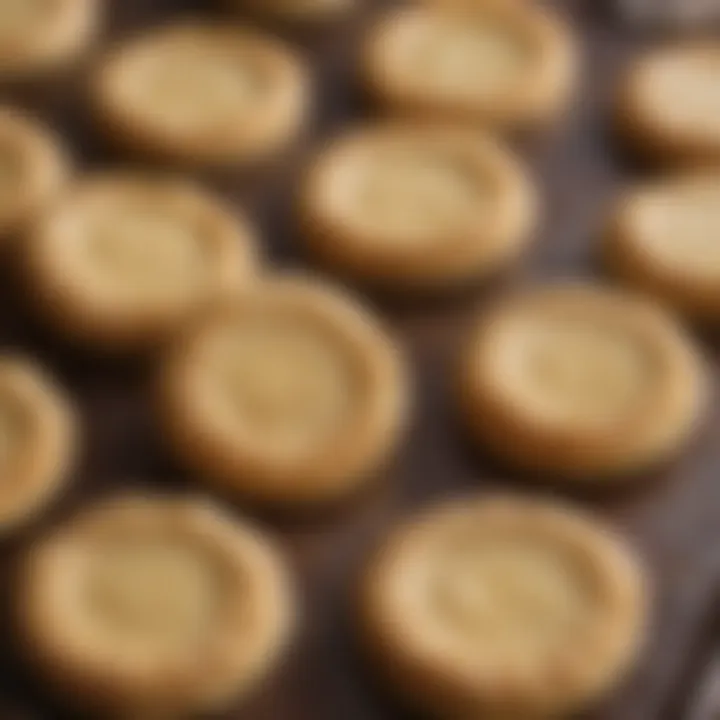Mrs. Fields Butter Cookies: Flavor and Technique


Intro
Mrs. Fields butter cookies are more than just a simple treat. They are a testament to the art of baking that blends rich taste with a nostalgic charm. From their warm, buttery aroma wafting in kitchens to their soft, melt-in-your-mouth texture, these cookies have become synonymous with comfort and indulgence. This exploration offers a nuanced understanding of why these cookies continue to endure, tracing their roots, techniques, and cultural significance that brings a smile to faces of all ages.
The journey to perfecting Mrs. Fields butter cookies is layered with flavor and craftsmanship. In this narrative, we will dissect the essential elements that make these cookies a crowd favorite, along with some practical tips that any baker can implement. Let's guide ourselves into the delectable world that is Mrs. Fields' cookies.
The Legacy of Mrs. Fields
When one meanders through the history of American baked goods, Mrs. Fields stands out as a hallmark of sweetness and comfort. The brand isn't just about cookies; it encapsulates a legacy that weaves through fine culinary arts and the everyday experiences of countless families. To grasp the significance of Mrs. Fields, one must consider not only the cookies themselves but also the philosophy of quality, innovation, and love that thrums at the heart of the brand’s success.
Founding Story
Mrs. Fields was founded in 1977 by Debbi Fields, a woman with more than just an interest in baking; she had a passion that seemed to transcend the ordinary. Starting from a small store in Palo Alto, California, it took time, grit, and a touch of destiny to create what we know as Mrs. Fields today. Debbi had a vision— to bring the aroma of freshly baked cookies into people’s lives. With determination as her secret ingredient, she pioneered recipes that kept a balance between indulgence and nostalgia. In those early days, there was a personal touch in each cookie that resonated with customers, allowing them to feel a connection to what was, for many, a slice of homely warmth.
Evolution of Recipes
As any skilled artisan would understand, invention often follows refinement. The evolution of Mrs. Fields recipes speaks volumes about the brand's adaptability and creativity. From those first iterations, which were straightforward chocolate chip cookies, the repertoire soon expanded to encompass a myriad of flavors. Cookies infused with nuts, sprinkles, and even seasonal varieties began to fill the display cases, allowing patrons to sample something new without straying far from that comforting taste. The hallmark of Mrs. Fields cookies lies in their balance; each flavor designed to evoke a sense of familiarity while inviting customers to discover something unique.
Expansion and Popularity
The expansion of Mrs. Fields is nothing short of extraordinary. As the late 20th century saw a rise in consumer culture, the cookies became synonymous with celebrations, gatherings, and indulgences large and small. Debbi Fields took her cookies beyond the corners of her shop, with franchises popping up across the nation, and then the world. From small towns to bustling cities, Mrs. Fields cookies found a place in the hearts of people of varying ages and backgrounds. This surge in popularity was not merely due to the tastiness of the cookies but also thanks to ingenious marketing that fostered a deeper emotional connection with customers, making it clear that these weren’t just treats; they were moments to share, to celebrate, and to enjoy together.
Understanding Butter Cookies
The exploration of butter cookies extends far beyond simple ingredients and recipes; it dives into a culinary adventure that emphasizes flavor, technique, and cultural significance. For many, butter cookies represent not just a treat, but a connection to home and heritage. Understanding the intricacies of these cookies illuminates their foundational role in baking, revealing how each element intertwines to create a beloved classic that resonates with food lovers across generations.
Defining Characteristics
Butter cookies possess unique characteristics that set them apart from other baked goods. Primarily, they are defined by their richness and tender crumb, attributed largely to the type of fat used—most notably butter. A common quality is their ability to melt in the mouth, offering a luxurious texture that makes every bite a delightful experience. Durability is also a characteristic; they hold their shape well during baking, making them ideal for intricate designs and shapes.
Texture and Flavor Profiles
Soft vs. Crisp
The debate between soft and crisp butter cookies often leads to passionate discussions among baking enthusiasts. Soft cookies bring warmth and tenderness, often associated with comfort. They are chewy, with a pliable texture that gives way under pressure. This softness is appealing especially to those who enjoy a cookie that feels like a warm hug. On the other hand, crisp cookies offer a satisfying crunch that many find delightful. The texture adds a layer of complexity, enhancing the experience when paired with a glass of milk or a cup of tea.
Both options have their merits; soft versions can sometimes cheat you out of what you expect from a cookie, while crisp ones risk being too rigid and lacking in flavor. The choice between the two essentially comes down to personal preference and what one hopes to achieve in flavor delivery.
Sweetness Levels
Sweetness is indeed a key player in the flavor profile of butter cookies. The range of sweetness can dramatically alter the final experience. A lighter hand with sugar can allow for the buttery flavor to shine through, providing a more nuanced tasting experience. Conversely, a sweeter cookie enhances the overall treat, turning it into a confectionery delight.
Balancing sweetness can be tricky; too much can overwhelm the palate while too little might feel underwhelming. Achieving that sweet spot is crucial to ensure that one is not led astray by cloying flavors.
Flavor Combinations
Flavor combinations transform an otherwise standard butter cookie into a sensational experience. Traditional choices include vanilla and almond, yet creative bakers explore new territories with exciting flavor blends. Think of citrus zests, spicy cinnamon, or indulgent chocolate swirls. Each combination introduces a contrasting element that can heighten the savory notes of the butter.
However, not all combinations resonate with everyone. A daring flavor choice might lead to divisive opinions, while some combinations may steal the spotlight from butter, diminishing its intended character.
Ingredient Chemistry


The Role of Butter
Butter plays a starring role in butter cookies, not just in the flavor department but in texture and moisture too. When butter becomes an ingredient, it brings creamy goodness and a depth of flavor that no other fat can replicate. The fat content helps to create that luxurious melting sensation in the mouth, something many bakers strive for.
That said, butter also brings its challenges—too much can lead to a greasy cookie that falls apart easily, while too little can result in a dry, crumbly texture. Addressing this balance is crucial for any baker.
Sugars and Their Effects
Different sugars can also have significant impacts on the outcome of butter cookies. Utilizing brown sugar alongside white sugar can contribute moisture and chewiness. Each sugar interacts with the fats and liquids in unique ways, affecting caramelization and browning.
Choosing the right type of sugar isn’t just about taste; it’s also about how they react during baking. Some sugars might lend themselves well to crispy cookies, while others could yield softer textures. Balancing these nuances is key for any cookie recipe.
Flour Varieties
The type of flour used in butter cookies can alter their structure and taste dramatically. Typically, all-purpose flour provides a good balance between tenderness and structure. However, using cake flour can yield a lighter texture, while bread flour might provide additional chewiness.
Ultimately, the choice of flour has consequences that reach far beyond mere texture. It influences the cookie’s ability to hold shape, its flavor, and even its nutritional value.
Together, these details paint a broader picture of what makes Mrs. Fields Butter Cookies so sought after and beloved. The balance of textures, flavors, and the chemistry behind the ingredients intertwine to create a delectable experience that speaks to tradition and creativity.
Classic Mrs. Fields Butter Cookie Recipe
The Classic Mrs. Fields Butter Cookie Recipe holds a distinctive place in not only the hearts of cookie enthusiasts but also in the broader spectrum of baking traditions. This recipe showcases the importance of quality ingredients and precise techniques, which are fundamental to achieving that delightful balance of softness and crispness that defines a perfect butter cookie. When diving into this recipe, one not only learns how to craft a beloved treat but also uncovers the nuances of flavor and texture that have cemented these cookies in popular culture.
Ingredient List
To embark on the journey of making Mrs. Fields Butter Cookies, it’s crucial to gather the right ingredients:
- Unsalted Butter: The star of the recipe, providing rich flavor and a tender crumb.
- Granulated Sugar: For sweetness and to achieve that characteristic melt-in-your-mouth texture.
- Brown Sugar: Adding depth and a hint of moisture.
- Eggs: Binding everything together while contributing richness.
- Vanilla Extract: A key player in enhancing the flavor profile.
- Baking Soda: The leavening agent that helps cookies rise just the right amount.
- All-Purpose Flour: The backbone of the cookie structure.
- Salt: Enhancing all flavors and balancing sweetness.
These simple yet effective ingredients are the cornerstone of a delicious butter cookie, emphasizing that baking does not always need complexities.
Step-by-Step Instructions
Preparation
Preparation is arguably one of the most vital phases in making cookies. It involves measuring out all ingredients precisely, which is crucial because even a slight deviation can lead to differences in texture and flavor. Begin by allowing the unsalted butter to soften at room temperature. This step ensures your butter mixes smoothly, contributing to an even texture.
Using softened butter allows for better incorporation of sugar, promoting a creamy consistency that’s hard to beat. When you mix in the sugars, the goal is to whip them together with the butter until the mixture is light and fluffy, creating air pockets that will help your cookies rise during baking.
Baking Techniques
When it comes to baking techniques, the method of mixing and the oven settings are paramount. For these cookies, after combining your wet and dry ingredients, consider using a spatula or wooden spoon for folding rather than an electric mixer. Folding helps maintain air in the mixture, ensuring your cookies stay fluffy instead of dense.
The pre-heating of the oven is another crucial step. Make sure your oven reaches a consistent temperature of around 350°F (175°C) before you bake. This consistency promotes even baking, making sure the inside of the cookie bakes through properly while the outside develops a nifty golden hue.
Cooling and Storage
Cooling and storage might not seem overly exciting, yet they play critical roles in the final outcome. Once your cookies emerge from the oven, allow them to sit on the baking tray for a few minutes. This short resting period lets the cookies firm up a bit and makes them easier to transfer without crumbling. A wire rack is the best choice for cooling; it ensures proper air circulation around the cookies.
Considering storage, ideally, keep your cookies in an airtight container. This maintains moisture, helping the cookies retain their chewy texture over time. If you plan on keeping them longer, consider freezing them, allowing for enjoyment at a later date without sacrificing flavor.
Troubleshooting Common Issues


Even with the most trusty recipes, common issues may arise. If your cookies spread too thin, it could be from using warm butter or not chilling the dough. Alternatively, if they come out too hard, the likely culprit might be overbaking. Here, consistency in preparation and mindful handling can mitigate those problems, leading to the desired results in both flavor and texture.
Exploring Variations
Exploring variations of Mrs. Fields butter cookies offers bakers and enthusiasts delightful opportunities to put a personal spin on a classic favorite. Each variation not only brings new flavors and textures to the table but also connects people through shared experiences of innovation in baking. This section will illuminate the benefits of experimenting with different ingredients and preparation methods, allowing for a deeper appreciation of the core recipe while embracing creativity in the kitchen.
Chocolate Chip Butter Cookies
One of the most beloved varieties of butter cookies is the chocolate chip adaptation. Chunks of semi-sweet or dark chocolate meld beautifully with the rich, buttery base. The contrast of textures between the gooey chocolate and the tender cookie creates a mouthwatering experience.
To make these cookies:
- Start with high-quality chocolate. Using bar chocolate instead of chips can elevate the flavor. Cut it into irregular chunks for a more rustic feel.
- Adjust the sugar slightly. Chocolate adds its own sweetness, so reducing sugar a touch can help balance flavors.
- Experiment with chocolate varieties. A blend of milk, dark, and even white chocolate can add complexity.
This variation often proves a hit at gatherings, providing a comfort that many associate with childhood. Throwing in a sprinkle of sea salt before baking enhances that sweet-salty dynamic, tying everything together.
Nut-Infused Options
Nuts can bring crunch and depth to Mrs. Fields butter cookies, offering a satisfying contrast to the soft, buttery body. Some popular nut options include pecans, walnuts, or even almonds, each introducing its unique flair.
When incorporating nuts:
- Roast them lightly. A quick toasting can amplify the nutty flavors, making them more aromatic and delicious.
- Chop them finely or coarsely based on personal preference. Coarser pieces provide a bold crunch, while finely chopped nuts meld more seamlessly into the dough.
- Consider pairing flavors. For example, almond extract can complement sliced almonds, or adding maple syrup for a nuttier flavor profile with pecans.
This variation caters to both nut lovers and those who appreciate a textured cookie.
Gluten-Free Adaptations
As dietary preferences evolve, so too can classic recipes. Making gluten-free adaptations of butter cookies ensures that everyone can enjoy this treat, regardless of dietary restrictions.
For gluten-free butter cookies, consider these points:
- Use gluten-free flour blends wisely. A combination of almond flour and coconut flour can create a lovely texture without the gluten.
- Add xanthan gum to improve the cookie's chewiness and structure — it substitutes the elasticity provided by gluten.
- Monitor baking times closely, as gluten-free cookies can often bake faster.
By making these adaptations, you can offer a delicious treat that's inclusive without sacrificing the delightful flavors that make Mrs. Fields butter cookies a classic.
In baking, variations are more than just substitutions; they are explorations of flavor, creativity, and preference, ultimately allowing the baker to craft a delightful personal favorite.
The Art of Baking Butter Cookies
Baking butter cookies is more than just a culinary task; it's a precise art form that involves mastering techniques, understanding ingredients, and keeping an eye on every detail. The perfect butter cookie gains its richness from high-quality butter, the right sugar balance, and careful attention to baking conditions. This section delves into the nitty-gritty of what makes these cookies a staple in both everyday life and special occasions, emphasizing that attention to detail can elevate flavors and textures.
Oven Calibration and Maintenance
An oven can be a baker's best friend or worst enemy. Calibration is crucial; an oven running even slighty off can wreak havoc on baking times and results. Most home ovens lose their accuracy over time. To ensure optimal performance:
- Test the temperature using an oven thermometer. Place it in the center and preheat. After it reaches the set temperature, check after a few minutes.
- Adjust the settings if necessary, following the manufacturer's guidelines. This might involve turning knobs or updating digital controls.
- Regularly clean your oven. Residue can affect performance and cause uneven heat distribution.
Maintaining your oven not only ensures even heating but also prolongs its lifespan, meaning fewer breakdowns when you're in the middle of a cookie-baking spree.
Baking Tools and Equipment
Choosing the right tools can influence the efficacy of the baking process. Certain baking equipment is essential for achieving that perfect Mrs. Fields butter cookie:


- Mixing bowls: Look for options that are deep and durable. Stainless steel is generally a solid choice.
- Stand mixers streamline the creaming of butter and sugar, which is a critical step.
- Silicone spatulas help in folding ingredients gently without deflating any air that’s been incorporated.
- Cookie sheets should be heavy-duty and flat; some bakers swear by non-stick options, while others prefer parchment paper to ensure easy removal.
These tools not only lend efficiency but also enhance the flavors by providing even mixing and uniform baking, which is what every cookie baker aims for.
Timing and Temperature Considerations
Timing plays a pivotal role in determining the outcome of butter cookies. Here's the general rule of thumb for consistency:
- Preheat your oven. Don't skip this step; giving your oven the right head start is what ensure even baking. Usually, 350°F works nicely for butter cookies.
- Monitor bake time closely—usually about 10-12 minutes. Every oven behaves differently, and that golden-brown look matters. The cookies should look set but still soft in the center.
- Allow cooling on the baking sheet for several minutes before transferring them to a wire rack. This helps firm them up a bit more and prevents them from breaking apart.
"Baking is science and art; both elements come together to make a perfect treat. Be patient, and trust the process."
By keeping a close eye on timings and temps, a home baker can craft cookies with that ideal texture—a crisp outside with a tender, buttery center.
With these insights into the art of baking butter cookies, anyone can embark on a rewarding journey of gastronomic pleasure, reinforcing why Mrs. Fields cookies have become a beloved classic. The importance of these elements cannot be overstated; when they align, they create a symphony of flavor and texture that is irresistibly delicious.
Cultural Impact of Mrs. Fields Butter Cookies
Mrs. Fields butter cookies represent more than just a delightful treat. They serve as a reflection of changing societal trends, attitudes toward food, and evolving culinary preferences. Understanding the cultural impact of these cookies illuminates their role as a staple in the lives of many, curating nostalgia while continuing to adapt to modern palates.
Cookies in Popular Culture
The place of Mrs. Fields butter cookies in popular culture cannot be understated. From television shows to social media posts, these cookies have found their way into the fabric of everyday life. For instance, they often appear in romantic comedies as symbols of comfort and care, subtly hinting that a shared cookie can bridge emotional gaps. People recall the warm, inviting aroma as they dive into their childhood memories, resonating with themes of home and familial connection.
With the rise of platforms like Instagram and Pinterest, these cookies are now frequently showcased in imagery that emphasizes their elegance and warmth, further solidifying their iconic status. Photogenic stacks artfully arranged often share the spotlight with hashtags like #cookiegoals and #treatyourself. This prevalence in digital culture reflects a growing interest in baked goods and the joy they bring.
The Role in Celebratory Events
Cookies from Mrs. Fields represent more than just flavors; they embody moments worth celebrating. Birthdays, anniversaries, or simply a successful week often call for these sweet delights. They stand as the unity tool, bringing people together around a table.
- Birthday parties: A box of assorted Mrs. Fields butter cookies often replaces traditional cakes, adding a unique twist to gatherings.
- Weddings or baby showers: These cookies invite a casual charm that becomes a talking point among guests, often packaged beautifully to complement the event theme.
Additionally, they are synonymous with holiday celebrations, making their way into gift baskets during festive season. The appeal lies not just in the taste but in the emotional connections they foster within families and friend groups.
Consumer Trends and Preferences
In recent years, consumer preferences have shifted toward gourmet and artisanal products. Interestingly, Mrs. Fields butter cookies have kept pace with these changes without losing their core appeal. As people become more health-conscious, offering gluten-free and less sugary varieties has opened new doors for the brand. Today's consumers are drawn toward quality over quantity, and the transparency about ingredients becomes a major influencing factor in their purchasing decisions.
Moreover, sustainability has entered the conversation as customers look for brands that prioritize ethical sourcing and environmental influences. Mrs. Fields has responded by promoting a commitment to high-quality, responsibly sourced ingredients—a detail that resonates strongly with broader consumer values.
End: The Enduring Appeal of Butter Cookies
In the world of baked delights, butter cookies hold a special place—not just within the shiny packaging of Mrs. Fields, but also in countless kitchens where they are mixed and baked with love. The remarkable legacy of these cookies—rooted in tradition yet adaptable in flavor—creates a lasting impression that speaks to both nostalgic consumers and adventurous bakers alike.
Reflections on Tradition
Delving into the tradition of butter cookies reveals a rich tapestry of flavors and techniques passed down through generations. Each batch holds a story, reminding us of family gatherings or simple evenings spent in the warmth of home. The simple yet comforting aroma of butter and sugar baking in the oven tends to evoke fond memories, making these sweets more than mere snacks—they are a kind of edible history.
Many families have their own variations of butter cookies, often infused with unique touches that represent cultural backgrounds or personal preferences. This aspect signifies a greater narrative about community and connection. Whether it’s a beloved aunt's secret ingredient or a regional twist, these cookies encapsulate personal stories, binding us to our heritage in subtle yet significant ways.
"Food is more than just sustenance; it's a gateway to memory and feeling. Butter cookies, with their rich history, embody that beautifully."
Future of Butter Cookies
As we observe the culinary landscape shifting toward new flavors and dietary needs, the future of butter cookies seems bright and full of creativity. There’s a growing interest in exploring alternative ingredients, such as alternatives for gluten or sugar, which can elevate the traditional recipe to fit modern health considerations without sacrificing the beloved classic taste. This evolution caters to a wider audience, ensuring that everyone, regardless of diet, can indulge in the warm, sweet appeal of these cookies.
Moreover, the fusion of different culinary traditions can introduce exciting new flavors. Imagine incorporating spices from global cuisines or unique pairings like lavender or matcha. With each new iteration, butter cookies can remain relevant and appealing to a diverse range of palates.
Ultimately, Mrs. Fields butter cookies are a testament to the timelessness of good food and the memories it can create. As long as there’s a place for baking and sharing, these cookies will continue to charm us for years to come.







